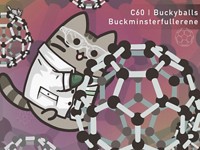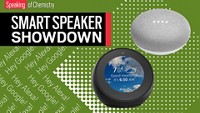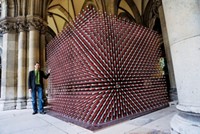Advertisement
Grab your lab coat. Let's get started
Welcome!
Welcome!
Create an account below to get 6 C&EN articles per month, receive newsletters and more - all free.
It seems this is your first time logging in online. Please enter the following information to continue.
As an ACS member you automatically get access to this site. All we need is few more details to create your reading experience.
Not you? Sign in with a different account.
Not you? Sign in with a different account.
ERROR 1
ERROR 1
ERROR 2
ERROR 2
ERROR 2
ERROR 2
ERROR 2
Password and Confirm password must match.
If you have an ACS member number, please enter it here so we can link this account to your membership. (optional)
ERROR 2
ACS values your privacy. By submitting your information, you are gaining access to C&EN and subscribing to our weekly newsletter. We use the information you provide to make your reading experience better, and we will never sell your data to third party members.
Science Communication
Newscripts
Colorful ways to celebrate science
by Bethany Halford
April 8, 2022
| A version of this story appeared in
Volume 100, Issue 12
Pins worn with pride

A few years ago, Jamie Gallagher, a professional science communicator based in Scotland, PhD chemist, and self-described massive geek, was planning to attend a Star Trek convention. Someone asked in a Facebook group if there would be any LGBTQ+ meetups there. “I was really surprised by the overtly homophobic response,” Gallagher says.
In response, Gallagher designed a rainbow-emblazoned enamel badge in the shape of the Star Trek insignia and asked if anyone would be interested in buying the pins. All profits would go to the Albert Kennedy Trust, an organization that helps LGBTQ+ youth in the UK who are experiencing homelessness or living in a hostile environment.

His post of the pin on Twitter got 50,000 likes, and orders flew in at warp speed. But it wasn’t long before the lawyers beamed in with a cease-and-desist order. Gallagher couldn’t sell the pins.
“I had discovered that people like rainbow badges. And so I thought, ‘OK, well, what else can I do?’ ” Although Star Trek is one of his passions, science is his home, Gallagher tells Newscripts. So he wondered what rainbow-themed science badges he could make.
He hit upon the idea of making a rainbow array of test tubes. It proved to be immensely popular. Since that small act of pride, Gallagher has made pins with 50 designs, which are available in his online shop, jamiebgall.co.uk/shop. He’s sent them around the world and raised about $8,000 for the Albert Kennedy Trust.
Gallagher says many teachers have bought his pins. “Thinking about what seeing a teacher wearing a rainbow badge in my classroom would have meant to me, as a young gay scientist, it just, it makes me quite emotional,” he says. “I’m incredibly proud to play just the tiniest part in making someone feel a little bit more comfortable.”
Elyas Salame’s Queer Chemistry project also features LGBTQ+ pins with a science theme. Salame, a trans, nonbinary artist based in Montreal, uses elements as representations of marginalized gender identity, sexuality, and attraction. For example, one pin uses the element symbol for praseodymium—Pr—and also features the Progress Pride flag.
“The idea behind the concept is that gender and sexuality are just as natural as chemical elements. In other words, every gender and sexuality are valid, natural, and thus deserving of pride and joy,” Salame writes on their website, yaspetitpoulet.com.
Salame tells Newscripts they would love to create a pin for each element on the table. In the past, they say, science has been used to discriminate against LGBTQ+ people. “I wanted to take a science thing and do something positive for the community.”
Science is a drag

Although Newscripts readers know better, science communication often has a reputation of being a staid endeavor practiced by suit-clad writers in university public relations offices or ex-researchers in sweatpants browsing academic journals from cramped home offices. Science communication seems to lack the glamour found in drag shows, where performers with punny pseudonyms in colorful costumes that challenge gender stereotypes delight audiences with outrageous acts. Science Is a Drag, an online show dedicated to explaining science through drag, comedy, and cabaret performances, explores the Venn diagram where science communication and drag intersect.
“It’s wild, wild fun,” says Carla Suciu, who helped bring Science Is a Drag to life with fellow science communicators Sam Langford and Brynley Pearlstone. “We’ve had physics explained through pole dancing,” Suciu tells Newscripts.
Drag is a good medium for communicating science, Langford says, because “it doesn’t take itself too seriously and comes across in a fairly accessible way.”
The show was originally intended to be a live event at the Glasgow Science Festival in June 2020, but the COVID-19 pandemic put a stop to that plan. “When June came around, we were in the midst of the UK’s lockdown and decided we wanted to resurrect the idea but look at it as an online event,” Langford says.
Having to pivot to an online show may have been a blessing in disguise, Suciu says. What was originally intended to be a onetime event has grown into a regular performance that has featured more than 50 performers from around the world. Attendees purchase tickets at a pay-what-you-can rate, and the performers split the proceeds. Langford and Suciu say they’re planning the next Science Is a Drag show for June.
Please send comments and suggestions to newscripts@acs.org.





Join the conversation
Contact the reporter
Submit a Letter to the Editor for publication
Engage with us on Twitter